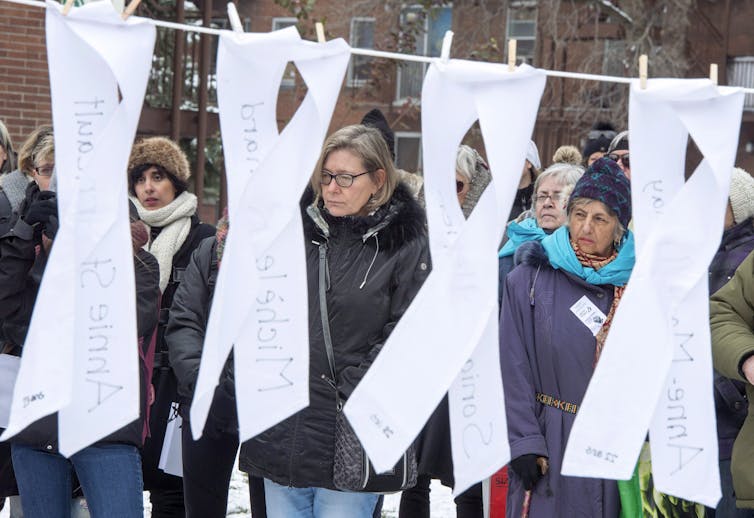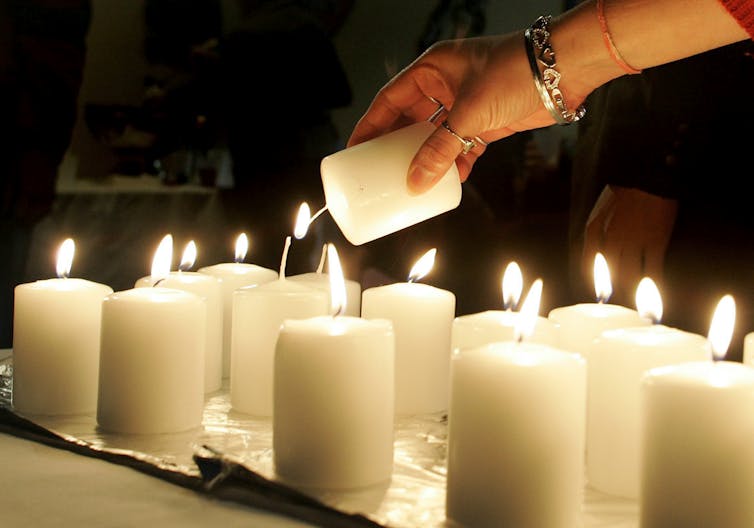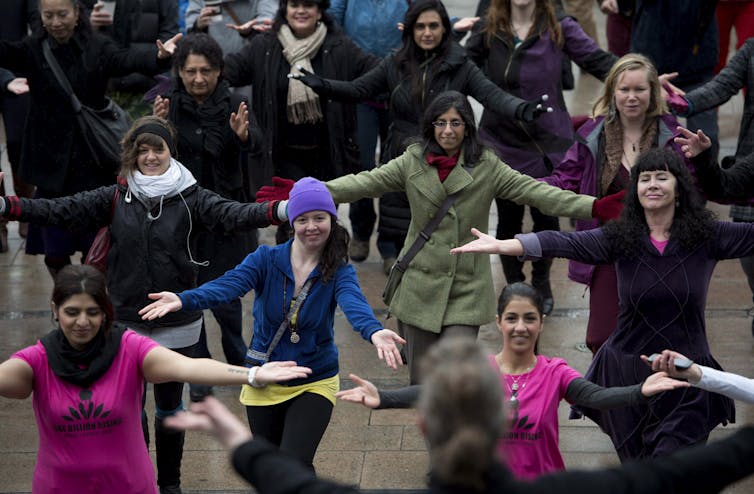
THE CANADIAN PRESS/Ryan Remiorz
Yasmin Jiwani, Concordia University
The National Day of Remembrance and Action on Violence Against Women falls on Dec. 6. The day, also called White Ribbon Day, was created by Canada’s Parliament in 1991 to mark the anniversary of the murders of 14 women — 13 of them engineering students — killed on that day in 1989 at l’École Polytechnique de Montréal.
Though statistics on the rates of reported violence against women in intimate relationships have declined over the last few decades, the reality is that violence against women has not abated. Half of all women in Canada have experienced physical or sexual violence.
Often the social and psychological costs of reporting gendered violence offers little recourse to justice. One out of every five women who reported being assaulted had their cases dismissed by police as “unfounded,” according to an investigative series in The Globe and Mail.
The recent heightened media attention on some high-profile cases has galvanized the public’s glare and gaze on these violations of human dignity. The #MeToo movement and the #BeenRapedNeverReported are examples of movements that have successfully raised public awareness.
Public attention often propels governments and leaders to take action in order to demonstrate accountability. But actually, we have yet to see the tangible outcomes. The reality is that these well-publicized cases just scratch the surface.
‘Intimate’ violence
Sexual assaults are just one point in the range of violence against women and girls. Violence against women spans an entire continuum: bullying, stalking, cyber-violence, dating violence, sexual abuse, financial abuse, elder abuse, trafficking, rape and murder.
Gender is a key determinant in this violence. In Canada, in the context of intimate violence, women are twice as likely as men to report being choked, beaten, threatened with a knife or gun and being sexually assaulted. Women and girls constitute almost 70 per cent of victims of family violence.
Contextual factors undoubtedly influence which women are more at risk of violence. Power dynamics adversely affect women: class, religion, age, sexuality and ability have an impact on vulnerability to violence.
Indigenous women are more vulnerable to different forms of violence — both intimate sexual violence and structural violence. The violence Indigenous women experience is rooted in colonialism, during which time they were sexually exploited by traders, colonial agents and miners. These relations of power still persist and influence how Indigenous women are perceived.
Women living in poverty are also more vulnerable. Girls aged 11 and younger are at the highest risk of femicide.
The harassment of Muslim women since Sept. 11, 2001, is another example. Subjected to gendered Islamophobia, they are more vulnerable to hate crimes targeting Muslims. They have been targeted across the country for wearing the hijab and niqab.

THE CANADIAN PRESS/John Woods
Similarly, women who have little or no access to services, or who are socially marginalized — such as the elderly, those in rural areas, women who are racialized and stigmatized, LGBTQ2 or gender non-conforming — are more susceptible to different forms of violence.
Transgendered individuals have consistently been maligned and killed because of their sexual identities.
It’s these intersections between gender, age, religion, sexuality, indigeneity and other aspects of identity that put specific groups of women at increased risk of violence.
A woman is killed every six days
The ultimate form of violence is death, and while homicide rates have declined nationally, women are still dying as a result of male violence. On average, in Canada, a woman is killed every six days by her intimate partner.
Historical and structural factors also influence the degree of vulnerability that particular women experience: the number of disappeared and murdered Indigenous women are now estimated to be around 4,000 and the rate at which they are murdered is seven times higher than non-Indigenous women.

CP PHOTO/Adrian Wyld
Numbers don’t tell the whole story. Clearly, histories and context matter. This is where the expertise of front-line workers, advocates, activists and academics can inform a viable strategy on how to end violence.
Activism to end such violence has a long history and it seems the solutions are within reach.
Less talk, more action
The federal government’s strategy to prevent and address gender-based violence, announced in June 2017, offers promise. Yet, so much of what the strategy is predicated on has been documented repeatedly in numerous consultations held over the last five decades or more.
Such consultations were carried out extensively and informed the final reports of the Canadian panel on violence against women established by the federal government in 1991 as a result of the massacre of young women at the École Polytechnique. Since then, there have been so many other consultations charting the terrain of gender-based violence.

THE CANADIAN PRESS/Jonathan Hayward
Isn’t it time to put consultations to rest? Funding clearly needs to be provided for necessary shelters, services and much-needed forms of intervention. A survey by Statistics Canada documented 8,000 women and children use these facilities to escape abuse.
I am not advocating for all action and no research. But instead, I am advocating for a research agenda which is participatory and focuses on how different systems are contributing to the perpetuation of gendered violence. Services require immediate funding but so do advocates and strategic research initiatives.
If gendered violence is to be eradicated, we need to start from ground up and traverse the pathways of its escalation, intervening at every step of the way with tangible nets of safety and security, eliminating the attitudes, barriers and values that keep such violence intact. Until then, the violence will continue unabated.
This is an updated version of an article that ran on Dec. 4, 2017.![]()
Yasmin Jiwani, Professor of Communication Studies; Research Chair on Intersectionality, Violence and Resistance, Concordia University
This article is republished from The Conversation under a Creative Commons license. Read the original article.




